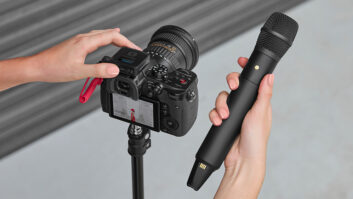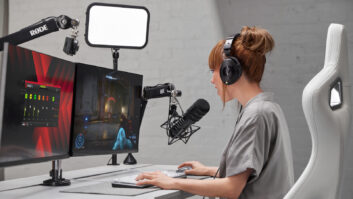RØDE microphones, which are designed and manufactured in
Australia and distributed in the United States by Event Electronics,
have earned an honorable position among recording professionals since
emerging on the market just a few years ago. The company’s first three
models, the Classic, NT1 and NT2, have all been adopted by leading
studios and the newest model, the NTV, a cardioid tube condenser microphone priced at $1,199, appears well
positioned to follow in the footsteps of its predecessors.
DESIGN AND CONSTRUCTION
The NTV is shipped in a package that leaves no question that this is a
serious recording instrument. Opening the box, I was greeted by a
heavy-duty aluminum flight case. Inside, foam pockets secured the
various components, including the dedicated power supply and power
cord, a 30-foot double-shielded oxygen-free multicore cable with
custom-tooled, military-grade gold-plated connectors, a stand-mount, a
birdcage shock-mount suspension and, of course, the microphone
itself.
The RØDE NTV is a substantial microphone. The instrument’s body
is milled from high-grade stainless steel and incorporates two grill
meshes. The inner headscreen is tightly woven and, even without the use
of a pop filter, provides reasonable protection from plosive sounds
caused by close-proximity miking. The NTV employs a 1.15-inch
gold-sputtered, edge-terminated Mylar diaphragm that is suspended in
the capsule by its edges. This new 1-inch edge-connected design is
significant, because without a center wire, the capsule is able to move
more freely, resulting in far more natural extended low-frequency
response. It is this single design characteristic that enables the
RØDE NTV to deliver a very pleasing warmth and transparency not
found in many other microphones.
Every aspect of the NTV’s design indicates there were no shortcuts
taken. The unit incorporates a hand-selected, low-noise, twin-triode
ECC81 valve combined with high-end, audiophile-grade capacitors from
Solen and Wima, all of which feed a custom-made Jensen output
transformer. The sum total of these components yields some impressive
numbers. The microphone’s sensitivity is rated at 15 mV/Pa while
maximum sound pressure level is a very respectable 130 dB. The NTV’s noise
rating is less than 19 dBA, and its output impedance is 200 ohms.
SESSION PREPARATION
The NTV’s power supply is solidly built and clearly labeled. It should
be noted that the unit will operate on both 120- and 220-volt AC
supplies, so it is wise to check the setting before powering the unit.
The cable that connects the microphone to the power supply is solid in
every aspect: Both ends are of the multipin (gold-plated for optimum
signal quality), threaded variety that secures into place by twisting
the ring until it is tight.
The NTV’s power supply provides an Earth Lift switch to reverse
polarity in the event of a ground loop. After connecting the microphone
to the power supply, all that’s left is to run a high-quality XLR cable from the power
supply to your console or preamp-ideally, one that is as short as
possible. Powering the unit lights is a blue LED on the front panel of
the power supply. (The LED’s drive circuit feeds off the filament
voltage of the microphone’s valve and thus becomes brighter as the
microphone approaches its operating level, providing a visual
indication when the NTV is ready for use.)
As stated earlier, the NTV ships with both a stand-mount and a
shock-mount support, each supplied with an inner ring adapter to fit
European-style mic stands. Even though both supports are constructed of
an industrial-grade PVC-type plastic, I found that the larger
shock-mount unit secured the microphone much better than the more basic
stand- mount adapter. In fact, I twice discovered that by the time I
had connected the cables and power supply to my console, the basic
stand-mount adapter had allowed the microphone to shift position ever
so slightly. Given the price of the instrument, the stand- mount
support did not exactly inspire confidence. I retired the stand-mount
and relied on the considerably more solid shock-mount (which worked
flawlessly) for the remainder of my evaluation.
The microphone itself is quite large and hefty, and secures to both
supports by resting in the base of the support while the supplied cable
attaches from the underside and locks the mic into place. This
certainly works, but it appears to me a somewhat rigid method of
securing the microphone. Shock-mount suspension systems from Shure, AKG
and others provide considerably gentler microphone handling.
SESSION USE
I began my evaluation by using the microphone for dialog recording.
After checking to ensure that I was indeed receiving signal, I began
experimenting with positioning. It became immediately apparent that the
NTV is extremely sensitive and its single cardioid pattern is very
clearly defined. For close-proximity dialog recording, I found the
microphone did a wonderful job, particularly when the instrument was
positioned at a side angle with the voice-over talent speaking across
the mic as opposed to directly at it.
As mentioned earlier, the NTV’s headscreen actually has an outer and
an inner mesh, with the inner mesh functioning as something of a pop
filter. I recorded the readings both with and without a dedicated pop
filter to see just how much reduction in plosive sounds I could
achieve. Although either set of recordings was more than sufficient for
my project, I ultimately chose to work with the takes that had been
recorded using the pop filter. I found that the takes with the pop
filter exhibited fewer plosives, and those plosives that were
objectionable were easier to clean up.
In terms of sound quality, I found the microphone provided a
pleasant low-end fullness that gave the dialog a warm, rich quality
without sacrificing the mid or high frequencies. The NTV’s performance
was very even and balanced, with no sound coloration.
I also had the opportunity to try the microphone in a small chamber
hall. Here, I recorded acoustic guitar and flute, both individually and
collectively. By positioning the NTV approximately six to eight feet
from the guitarist, I was able to capture a fairly direct sound, yet
there was also enough distance to pick up some of the refractive sound
energy from the hardwood floor. In this environment, the NTV delivered
a clearly defined performance, along with all the guitar harmonics that
Heitor Villa-Lobos’ compositions are famous for. I could distinguish
fingerpickings while still gaining a sense of spaciousness that is
characteristic of the room.
My experience in recording the flute was equally successful. In this
case, the NTV’s internal mesh enabled me to position the microphone
fairly close without being disturbed by all the breath and plosives
common to the instrument. I found the microphone captured both the
instrument and the acoustic characteristics of the hall very accurately
and without any harshness. In this case, the slight fullness in the
lower frequencies did a nice job of making the recording seem big and
full.
Priced at $1,199, the RØDE NTV is a well-balanced recording
instrument that provides exemplary performance under a variety of
applications. I would feel confident using this microphone for ensemble
recording, vocal work, piano and other acoustic instruments, as well as
overhead miking of percussion. Its tendency to slightly round out the
lower frequencies of a recording without coloring the sound adds a
depth that many will find beneficial. The fact that the microphone
offers only one polar
pattern (cardioid) was initially somewhat disappointing, but I
consider this to be a reasonable trade-off in light of the price. Aside
from my experience with the stand-mount support and the mounting method
in general, the new RODE NTV is a well-made, quality instrument that
will make a fine addition to any recording studio’s microphone
arsenal.
RØDE Microphones, www.rodemic.com







